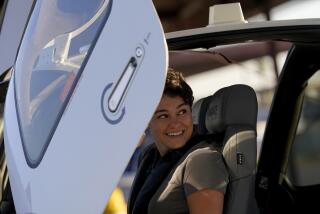Running Out of Steam Fuels Risk for Human-Power Aviators
- Share via
Long-distance cyclists call it “bonking.” Marathoners and cross-country skiers call it “hitting the wall.” Other athletes use more colorful expressions. But they are all talking about the same phenomenon: that point in an endurance contest where muscle cells begin to run out of fuel or the body becomes dehydrated and every tissue in the body is telling it to give it up.
“In any endurance contest, if you don’t have enough water, if you get overheated, or if your body hasn’t stored enough energy, you are not going to make it,” said physiologist Peter Van Handel of the U.S. Olympic Training Center in Colorado Springs.
Bryan Allen hit the wall a little over halfway through his 22.5-mile 1979 flight across the English Channel in the Gossamer Albatross, the most successful human-powered aircraft to date. He finished the flight, but only through sheer willpower.
Lois McCallin may hit the wall next week, weather permitting, when she is scheduled to pedal the Michelob Light Eagle airplane around a 30-mile course at Edwards Air Force Base to break Allen’s distance record for human-powered flight.
During the expected two-hour attempt, McCallin’s 122-pound body will lose at least four pounds of water and her muscles will quickly begin to cramp if it is not replaced.
Also during the flight, her body will be burning the caloric equivalent of nearly two Big Macs every hour. If there is no head wind and conditions are right, she will have enough energy stored in muscle cells in the form of sugars called glycogen.
But if weather conditions force her to work harder, thus using up her stored glycogen, McCallin’s muscles will become much less efficient--sputtering along like a car whose fuel tank has only a little gasoline sloshing around.
During the flight, McCallin will face a physical barrier that affects all humans. Muscles burn glycogen to produce the energy required for the muscle contractions that move arms and legs. But the process is very inefficient--only 20% to 25% of the energy is actually converted into motion.
The rest of the energy is converted to waste heat--enough to raise her body temperature by at least one degree every five minutes if there is not enough ventilation in the cockpit to allow her to shed the heat by perspiring.
That extra heat makes cells operate less efficiently so that they become fatigued much more rapidly than normal. Overheating can also cause muscle and brain cells to break down, causing seizures and releasing proteins that clog the kidney and cause it to stop functioning.
“We are so close to the edge (of human endurance) that any vagary in the environment--wind, frost, and so forth--could end the flight very quickly,” said Ethan R. Nadel, the Yale University physiologist who has helped select and train the pilots.
High Power Requirement
Flying the plane is much different from competing in any other kind of endurance contest, Nadel said. “If you are running (and) you can’t develop enough power, you simply slow down. But if you are pedaling a plane, you can’t do that. A certain amount of power is necessary to keep the plane in the air.”
And the power requirement is very high, he added. “Even most excellent athletes don’t have the ability to produce that power for an extended period.”
According to MIT aeronautical engineer John S. Langford, the leader of the Daedalus Human Powered Flight Team, the pilot has to produce about 3.25 watts of power per kilogram of body weight--the equivalent of 0.27 horsepower for McCallin. That power output is the equivalent of climbing a 10,000-foot mountain in four hours or pedaling a bicycle at 25 m.p.h. for the same period, feats difficult even for trained athletes.
But the human body can produce full power only for periods of a few minutes or less. At maximum power output, part of the power comes from a process known as anaerobic metabolism, in which fuels are burned without oxygen.
‘Muscle Poison’ Produced
Anaerobic metabolism, said Nadel, “produces lactic acid, which is a muscle poison that causes them to stop working.” It can thus be relied upon only in short-term athletic events, such as sprints or weightlifting.
In endurance events, he said, athletes normally run or cycle at about 70% of maximum power.
To maintain a power output of 3.25 watts per kilogram, therefore, prospective pilots would have to be able to produce a maximum output of at least 4.25 watts per kilogram. Nadel has tested nearly 30 “elite athletes,” including amateur soccer players, cyclists and wrestlers, and fewer than a third of them were capable of producing at that level.
One was McCallin, a 30-year-old financial analyst from Boston whose hobby is competing in triathlons. In triathlons, competitors swim 2.4 miles, cycle 112 miles and finish by running a marathon (26.2 miles).
Another was the current back-up pilot, Glen Tremml, a 27-year-old first-year medical student at the University of Connecticut who is also a triathlete.
Biggest Potential Problem
McCallin and Tremml were chosen for the upcoming endurance trial because they were already licensed pilots.
The biggest potential problem McCallin will face, most experts agreed, is dehydration. When the body loses water, the volume of blood decreases and the heart has to work much harder to get enough oxygen to the extremities. In order to maintain a flow of nutrients and oxygen to muscles, Nadel explained, the body restricts the flow of blood to the skin.
“When that happens you stop sweating, and when you stop sweating you’re in real danger” because you overheat even faster, said John Howard, the 1981 winner of the Ironman Triathlon in Hawaii who now trains other triathletes.
Dehydration also causes a buildup of sodium and potassium ions in the blood, according to physiologist James Herkimer of the National Athletic Health Institute in Inglewood. “That causes muscle cramps that can take you out of a . . . race.”
Flight Nearly Aborted
Bryan Allen’s cross-channel flight was nearly aborted because of dehydration. The planned time for the flight was about 90 minutes and he had enough water for 90 minutes. But Allen ran into head winds and turbulence that slowed him significantly and he ran out of water halfway across the channel.
“I got really bad cramps and was ready to quit,” Allen said in a telephone interview. “I signaled the chase boat to get ready to tow me, but I had to climb higher to hook up. When I got higher, there was less turbulence, so I went on.” The flight took two hours and 49 minutes.
McCallin will drink at least a quart of water every hour and will carry extra water in case the flight goes longer than scheduled.
Athletes hit the wall most often, Van Handel said, because they run out of energy. “When that happens,” he said, “the nervous system will recruit other available cells that are not normally used in that task. You’re suddenly using muscle cells that haven’t been trained,” and they are much less efficient.
Energy for Muscle Cells
Most energy for muscle cells comes from carbohydrates, which are complex sugars such as those found in bread, potatoes and pasta. In the body, these carbohydrates are converted into glycogen that is stored in cells as an energy source. “Normally, if you eat too many carbohydrates, they are turned into fat,” Herkimer said.
“But if you drain all the glycogen out of the muscles” by training heavily in your event three or four days before it is scheduled and then not consuming carbohydrates until the day before, he added, “you can fool the muscles into loading up with much more glycogen, almost twice as much.” This process is known as carbohydrate loading and it is controversial.
“The biggest problem with this,” said physiologist James A. Davis of California State University, Long Beach, “is that it takes an athlete out of his normal (training) sequence, disrupts his bowel movements, gives him gas, and disrupts him psychologically. But if he has done it before, he can get used to the side effects.”
Carbohydrate Loading
The Olympic Training Center does not endorse carbohydrate loading. “We recommend that endurance athletes reduce training before an event to give the body a chance to build up carbohydrate levels,” Van Handel said.
McCallin and Tremml will not use carbohydrate loading for the 30-mile flight.
The team is much more concerned about the pilot conditions during a proposed 69-mile flight between Crete and mainland Greece that would recreate the escape of Daedalus and his son Icarus from imprisonment.
That flight is tentatively scheduled for this fall or the spring of 1988.
And for it, the pilots may resort to carbohydrate loading, Nadel said. Because it will take each pilot four to five days to prepare for the flight, he added, the team will have five prospective pilots available, each peaking on a different day, so they can go whenever the weather is favorable.
Can they make it? “If they are working below a level that causes excess fatigue, and if they’ve trained to cycle four or five hours,” Herkimer said, “I think they can do it without any problem.”
More to Read
Go beyond the scoreboard
Get the latest on L.A.'s teams in the daily Sports Report newsletter.
You may occasionally receive promotional content from the Los Angeles Times.






